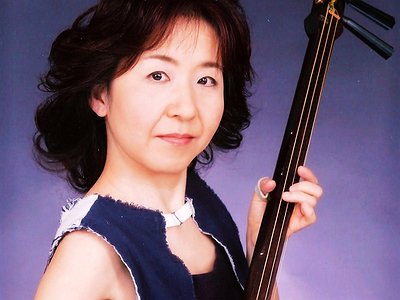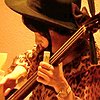Part 1
Name: Yumiko Tanaka
Nationality: Japanese
Occupation: Shamisenist, Improviser
Musical Recommendations: KKNULL, Kazuhisa Uchihashi
When did you start playing your instrument, and what or who were your early passions or influences?
I started to play the“shamisen” at the age of 18. I was inspired by “Gidayu-shamisen” masters when I first saw Bunraku puppet theatre at the National Theatre in Tokyo. Until then, I had played classical music on the piano every day. So my first passion was for practicing traditional shamisen under a master shamisen player in Bunraku. During my high school years, I liked to listen to contemporary music.
I started to play fusion music with the big band “Haniwa All Stars” led by legendary drummer and Japanese Kabuki percussionist Kiyohiko Semba. The band also included jazz musicians like Akira Sakata, Kazutoki Umezu, and Kazumi Watanabe around 1990. Soon, I came to know about improvisation music by the Noh theatre flutist Yukihiro Isso when I joined in his small band for the theatre performances. At that time, I liked to listen to ECM records.
In 1995, I had a chance to perform John Zorn’s COBRA prompted by the vocalist Koichi Makigami in Tokyo. After that, I joined the U.S. tour of Conduction by Lawrence D. "Butch" Morris, and joined in the band GROUND ZERO led by Yoshihide Otomo. That's how I started to improvise on the shamisen.
For most artists, originality is first preceded by a phase of learning and, often, emulating others. What was this like for you? How would you describe your own development as an artist and the transition towards your own voice?
There are only few improvisers of traditional instruments in Japan so far. The only one I knew as an improviser on the shamisen was Michihiro Sato when I started to improvise, and he was a Tsugaru-shamisen player. The musicality of the Tsugaru-shamisen is very different from my Gidayu-shamisen, but the improvisation CD by John Zorn and Sato was helpful for me to learn something about improvisation. And COBRA was also a kind of a textbook about improvisation for me. I’ve tried to learn everything about improvisation from every other improvisers around me when I perform with them at improv gigs.
I‘ve observed the tools and the styles of string players at these gigs. Especially, the Festival Beyond Innocence organised by Kazuhisa Uchihashi from 2002 to 2007 in Kobe and Osaka was a happy place to research about improvisation. But I couldn’t emulate the other players, because my instrument was very different from the guitar or the cello, and I really wanted to make use of the character of the shamisen. It is hard to say what constitutes an emulation and what is my own voice generally. I tried to improvise using quotations of some fragments from traditional pieces at first - and gradually I transformed it.
Tell me about your instrument, please. How would you describe the relationship with it? What are its most important qualities and how do they influence the musical results – and possibly even your own performance?
The shamisen is a Japanese traditional plucked instrument which has three strings, and was widespread among the common people during the Edo period (from the 17th century to the middle of 19th century) as an accompaniment instrument for folk songs or narrative music.
They were first used to accompany songs among the blind musicians who performed Heike-biwa or koto music, and performed at celebrity salons as chamber music with koto or shakuhachi. Over time, they were gradually used as an accompaniment for the stage music in Kabuki theater or Bunraku puppet theater, and also the popular songs in red-light district of Edo, variety halls, or street performances.
The neck of the shamisen is fretless and the body has a taut front and a back with cat or dog skin.
The wooden pegs are used to wind the strings. The three strings are made of silk. The strings are stretched across the body and we set a bridge between the strings and the leather. The bridge is made of ivory or tortoiseshell, aged bamboo, wood, buffalo horn. The strings are plucked with a plectrum shaped like a ginkgo leaf. They are made of ivory, or tortoise-shell, and often used to strike both string and leather, creating a percussive sound.
The size of the neck and the body varies depending on the genre or school in which it is used. The plectrum and the bridge also differ in size, shape, and material from genre to genre.
My shamisen is a thick-necked type, and it is used in the traditional puppet theater “Bunraku”, and accompanies the narrative music called Gidayu-bushi.
So they call it a “Gidayu-shamisen”.
The Tsugaru-shamisen, which developed from the folk song at the Tsugaru district at the end of 19th century is also thick-necked type, and very popular among young people in Japan because of its highly instrumental music style involving virtuosic technique and its dynamic rhythm.
The most important quality of the shamisen is a characteristic sound quality with a rich resonance, a drone, overtone, which we call “Sawari”. So I always try to make or find lots of rare and unique sounds when I perform. And I try to narrate or sing with the shamisen also, because the sound of shamisen becomes more attractive with the voice.
These days, I also use the “Taishogoto”. The taishōgoto is a Japanese stringed musical instrument. The name derives from the Taishō period (1912–1926), when the instrument first appeared. The taishōgoto consists of a long, hollow box with steel strings running across its length. We push numbered typewriter-like keys above the strings to raise their pitch. I use electrified versions with an effector.
And I also use the original electronic instrument “shaminome”. It is a kind of sampler at this moment, but I want to improve it more in the near future.
What were some of your main artistic challenges when starting out as an artist and in which way have they changed over the years?
Regarding the traditional shamisen, I had to memorize the long text and practice the same piece again and again. Regarding composed music, I had to practice again and again to perform many passages which were hard to play.
But improvisation is a kind of delightful enjoyment in contrast to traditional music or composed music. (That also means I have never made a living by improvisation.) I have always tried to find happy moments with improvisation so far without any hard exercise or special challenges. So there have not been particularly many artistic challenges until now in my improvisation career. I have just tried for things to be more fun every time. So, maybe my main challenge has been “not to be bored with my previous performance”. This hasn't changed over the years.
What do improvisation and composition mean to you and what, to you, are their respective merits?
Improvisation is discovering a new connection or new phase between the instrument and myself, or between me and other performers. This means that I can control a wide range of factors by myself, which makes it so enjoyable for me and I can feel a lot of “freedom”. I can change the piece with perfect freedom whenever I want to during the performance. And I can chat with musicians and the audience with my sound without speaking any language. I can be myself whenever I improvise, which is absolutely delightful for me.
When I compose the piece, I can take time to develop the idea. And I can rewrite it any time before it is completed. And it will be recorded as a score forever. But once it is fixed, you must do the same thing forever with that score.
And when I perform composed music by others, I feel the piece in itself is almost equal to the composer himself, and I have to express what he wants to say on his behalf through my filter to the audience. It is sometimes stressful for me to express someone else's personality. On the upside, it means “I don’t have to be myself”.






